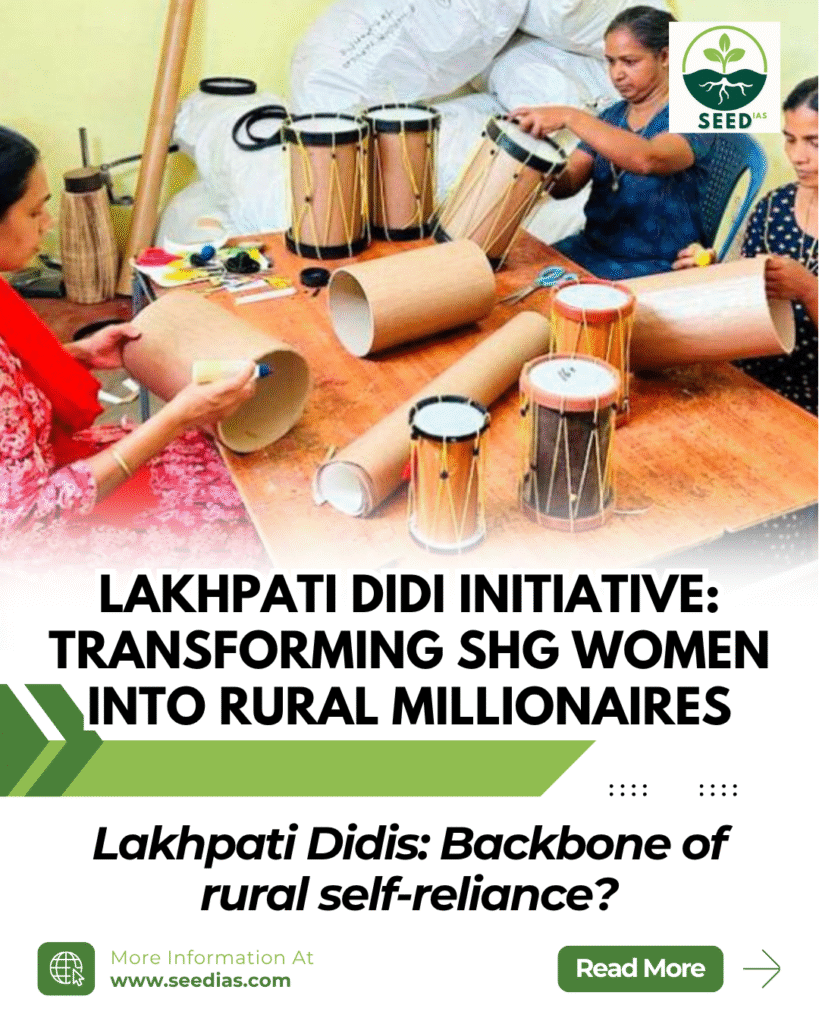Why in NEWS
The Ministries of Rural Development and Skill Development signed an MoU to strengthen the Lakhpati Didi Initiative by training Self Help Group (SHG) women in emerging sectors, aiming to create 3 crore Lakhpati Didis, aligning skills with rural aspirations.
Key Terms and Concepts
| Term | Description |
|---|---|
| Lakhpati Didi | SHG woman earning ₹1 lakh+ annually through sustainable livelihood activities |
| DAY-NRLM | Deendayal Antyodaya Yojana – National Rural Livelihoods Mission, MoRD’s flagship rural livelihood scheme |
| SHG (Self Help Group) | Small informal group (mostly women) pooling savings, accessing microcredit, and engaging in income-generating activities |
| CRPs (Community Resource Persons) | Trained SHG members who provide support, training, and guidance to other groups |
| MoU | Memorandum of Understanding signed for inter-ministerial collaboration |
News in Simplified
The Government aims to empower rural women by converting them into Lakhpati Didis—women earning ₹1 lakh+ per year. The recent MoU ensures that SHG women are trained in digital tools, modern skills, and given support in branding, marketing, and financial access. The target is to create 3 crore such women by aligning various government schemes with skill training and livelihood creation.
Key Features of the Lakhpati Didi Initiative
| Feature | Details |
|---|---|
| Target Group | SHG women under DAY-NRLM |
| Income Benchmark | ₹10,000+ monthly average income for 4+ agricultural/business cycles |
| Livelihood Sectors | Agriculture, services, crafts, allied activities |
| Support Strategy | Assets, skills, finance, market access |
| Skilling Focus | Digital tools, structured programs, financial literacy |
| Collaborations | Skill India, PM SVANidhi, MGNREGA, CSR partners |
SHG: Structure and Role
| Element | Function |
|---|---|
| Membership | 10–20 people, mostly women |
| Savings & Lending | Members pool money; used for internal lending |
| Bank Linkage | SHGs get loans after 6 months of operation |
| Training | Provided by NGOs, govts, and banks in literacy, skills |
| Record Keeping | Maintained by one trained member |
| Loan Repayment Rate | Over 96% as per Economic Survey 2022–23 |
Why SHGs Matter for India
| Impact Area | Contribution |
|---|---|
| Women’s Empowerment | Enhances confidence, decision-making, political participation |
| Financial Inclusion | Brings banking to marginalized, offers fair credit |
| Poverty Alleviation | Enables self-employment, income generation |
| Rural Economy | Promotes local entrepreneurship and collective action |
| Social Change | Tackles issues like domestic violence, sanitation |
| SDG Contribution | SDG 1 (No Poverty), SDG 5 (Gender Equality), SDG 8 (Decent Work) |
Challenges Faced by SHGs
| Category | Issues |
|---|---|
| Financial | Credit access hurdles, irregular savings, loan defaults |
| Operational | Poor management, dependence on few members |
| Social | Gender roles, caste barriers, lack of awareness |
| Policy-Related | Delays in bank linkage, bureaucratic interference |
| Sustainability | Weak market linkages, high dropout rates |
Suggested Improvements
| Area | Actions Needed |
|---|---|
| Credit Support | Simplify bank linkage, promote micro-insurance |
| Market Access | Leverage e-commerce, improve branding and pricing |
| Private Partnerships | Use CSR, tech mentorships (e.g., Google Women Will) |
| Policy Interventions | Timely subsidies, GST relief, SHG federations |
| Social Inclusion | Focus on SC/ST, disabled, landless; promote gender awareness |
| Regional Equity | Special efforts in North and East India |
SHG-Bank Linkage Programme (SHG-BLP)
| Aspect | Details |
|---|---|
| Launched By | NABARD in 1992 |
| Purpose | Link SHGs with formal banking for savings and credit |
| Loan Eligibility | After 6 months of regular savings |
| Linkage Models | 3 types: bank-led, NGO-supported, NGO as intermediary |
| Loan Types | Microcredit, term loans, revolving funds |
In a Nutshell:
Mnemonic – “WIFE-PROMS”
- Women Empowerment
- Income Generation
- Financial Literacy
- E-Commerce Access
- Priority Lending
- Rural Development
- Operational Training
- Market Linkage
- SDG Alignment
Prelims Practice Questions
- Which of the following is NOT a pillar under the Lakhpati Didi initiative?
A) Market Access
B) Skill Development
C) Subsidy Distribution
D) Financial Linkage - With reference to Self Help Groups in India, consider the following statements:
- SHGs are always registered under the Societies Act.
- SHGs promote collective saving and lending.
- Kudumbashree is an SHG initiative in Kerala.
Which of the above are correct?
A) 1 and 2 only
B) 2 and 3 only
C) 1 and 3 only
D) 1, 2, and 3
- The SHG-Bank Linkage Programme was launched by:
A) RBI
B) NABARD
C) SIDBI
D) NITI Aayog
Mains Practice Questions
- (GS2 – 2022) “Self Help Groups are effective tools for women empowerment and poverty alleviation.” Critically analyze with recent examples.
- (GS3) Discuss the role of Lakhpati Didi Initiative in promoting sustainable rural livelihoods and inclusive development in India.
Answer Key with Explanations
| Qn | Answer | Explanation |
|---|---|---|
| 1 | C | Subsidy distribution is not a core pillar of the initiative (Assets, Skills, Finance, Market Access are) |
| 2 | B | SHGs are informal and not necessarily registered; Kudumbashree is a well-known SHG initiative |
| 3 | B | SHG-BLP is a NABARD initiative started in 1992 to promote financial inclusion |
















